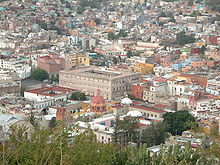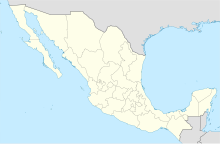Alhóndiga de Granaditas
 |
|
| Established | 1958 |
|---|---|
| Location | Mendizabal 6, Historic District, Guanajauto, Guanajauto |
| Coordinates | 21°01′08″N 101°15′29″W / 21.0189°N 101.2581°W |
| Type | History museum |
The Alhóndiga de Granaditas (Regional Museum of Guanajuato) () is an old grain storage building in Guanajuato City, Mexico. This historic building was created to replace an old granary near the city's river. The name translates roughly from both Arabic and Spanish as grain market or warehouse. Its construction lasted from 1798 to 1809, by orders of Juan Antonio de Riaño y Bárcena, a Spaniard who was the quartermaster of the city during the Viceroyalty of New Spain. The building received World Heritage listing as part of the Historic Town of Guanajuato in 1988.
The Alhóndiga is an example of Neoclassical ideas. The original design was drafted in 1796 by Josė Alejandro Durán y Villaseñor, who was the master of public works. Josė de Mazo y Avilés modified the plans later.
It measures 72 by 68 metres, with a height of 23 metres, and occupies an area of 4,828 square metres. It is constructed on the side of a hill and two of its sides are surrounded by elevations. There are no ornamental facets on the exterior, except for a few windows at the top of each storage room. It has cornices built in a Doric style, constructed with two types of regional stone—reddish and greenish. This gives it a curious appearance, resembling a stronghold or a castle, which it has come to be called by the people of Guanajuato. In the interior, there is a porch that leads to a spacious central patio. The porch contains Tuscan columns and adornments. There are two staircases that lead to the upper floor. The Alhóndiga has only two access doors, a small one facing the east, adorned by two columns, and a large door of the same basic style, facing the north. The edifice was used for the buying and selling of wheat, corn, and other grains. Prior to the Mexican independence from Spain, it was used as a warehouse, military barracks, and prison. Currently it serves as a regional museum.
When Miguel Hidalgo y Costilla's insurgent troops threatened to take over this city during the Mexican War of Independence, Riaño secured himself in the Alhóndiga on 28 September 1810, along with many other Spaniards and some rich criollos. There were about 300 loyalists who took refuge from 20,000 rebels led by Hidalgo. Riaño believed that the strength of the building, its ample supplies and its positioning would make it easy to repel the insurgents' attacks. In addition to the corn the building already held, other provisions and twenty-four women were brought in to "make tortillas."
...
Wikipedia

